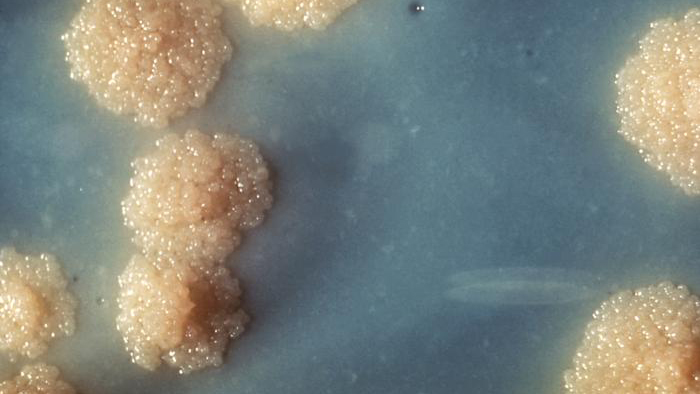News
Grant Will Support Annotation of Metabolic Networks in Pathogenic Bacteria

M. tuberculosis bacterial colonies. Photo credit: CDC/Dr. George Kubica [Public domain], via Wikimedia Commons
Dennis Vitkup, an associate professor in the Columbia University Department of Systems Biology and Department of Biomedical Informatics, has been awarded an R01 grant from the National Institute of General Medical Sciences (NIGMS) to develop a computational pipeline for predicting bacterial metabolic networks. Building on a framework called GLOBUS that was previously developed in his lab, the project will produce probabilistic annotations of metabolic networks for all of the major bacterial species that cause disease in humans. It will both offer a method that can be used to study metabolism in any species of bacteria and produce valuable information that will aid researchers who are looking for therapies against many of the world’s most deadly pathogens.
This effort, titled "Annotation of Orphan Metabolic Activities," is timely because of the opportunities that genome sequencing now offers. More than 3,500 bacterial genomes are now available and approximately 15,000 more are currently being sequenced; considering the accelerating pace of these efforts it is estimated that scientists could have access to the complete genomes of more than 100,000 bacterial species within a decade. However, currently available methods for annotating the molecular interactions that drive metabolism are limited, making it very difficult for the scientific community to take advantage of this revolution. A more accurate method for characterizing metabolic networks for any bacterial species could enable researchers to better understand how bacteria evolve, identify potential new drug targets, and address the growing threat of antibacterial drug resistance.
“From a basic biological perspective, reconstruction of species-specific metabolic networks often provides the most direct route toward understanding bacterial growth phenotypes, primary nutrient sources, and potential metabolic interactions with the environment and other bacteria,” Vitkup says. “Previous research in our lab has also shown that targeting metabolism is very effective, and systematic metabolic modeling based on accurate annotations is likely to yield multiple new targets and corresponding inhibitors.”
The computational method the Vitkup lab has developed, called GLOBUS (Global Biochemical Reconstruction Using Sampling), generates global probabilistic models of metabolic networks. GLOBUS has been found to have a number of advantages over other approaches for modeling metabolic networks, including its ability to integrate multiple types of complementary data and to generate probabilities that two molecular components actually interact. The Vitkup lab has used GLOBUS in the past to successfully predict unknown metabolic activities, molecular pathways that play important roles in metabolism, and targets for potential therapeutic intervention. Under this new grant, the lab will enhance GLOBUS by incorporating new types of data, including protein structural information, metabolomics data, and information about bacterial growth in different environmental conditions. Increasing the kinds of information that the algorithm considers beyond pure genomic data will greatly enhance its accuracy.
The project's biological focus will be on approximately 50 of the most common pathogens that humans face, including bacterial species responsible for tuberculosis, plague, cholera, anthrax, pneumonia, and other diseases. To develop the models of bacterial metabolic networks, the researchers will obtain phenotypic data from three different sources representing how each bacterial species grows under a panel of different nutrients and conditions. Metabolomics data for a subset of key bacterial species will be collected by Uwe Sauer, a co-principal investigator on the grant who is based at ETH-Zurich. Researchers in his lab will generate this data using high-resolution mass spectroscopy technologies within biosafety level 2 or 3 facilities, which are designed to protect researchers from infection and prevent dangerous pathogens from being released into the environment.
Utilizing all of this information, the Vitkup lab will then use GLOBUS to generate probabilistic annotations of metabolism for each of the bacterial species. In addition to phenotypic and metabolomic data, GLOBUS will also consider the structures of all proteins to judge whether two proteins are physically capable of interacting. For proteins for which protein structures have already been determined, GLOBUS will incorporate information from the Protein Data Bank. When no experimentally confirmed structure is available for a particular protein, the researchers will use a technique called homology modeling, which can computationally predict a protein’s structure and its active sites of interaction based on the similarity of its genomic sequence to that of other proteins with known structures.
Based on the annotations that GLOBUS generates, the Vitkup lab will build flux balance analysis models, which can simulate the effects of all possible single and double gene deletions on the bacterial metabolic networks. This approach will help to identify key genes that are essential for the function of metabolic networks and therefore hold potential as new therapeutic targets.
Over the course of the project, the Sauer laboratory will also validate approximately 30 biochemical activities that are important for the biology of selected pathogens. To avoid the dangers of working with lethal organisms, they will use third party services to synthesize DNA sequences corresponding to the predicted activities, sub-clone them in E. coli, and then perform in vitro validation of enzymatic activity in the laboratory. These efforts will begin with a focus on biochemical activities in M. tuberculosis because of the severe global need for new therapies against it.
As the project proceeds, Dr. Vitkup anticipates, the investigators will make GLOBUS predictions for over 2,000 sequenced bacterial genomes. These will be accessible through a website that will also enable users to submit gene expression, metabolomics, and phenotype data. Disseminating information and enabling input from the community in this way will improve the usefulness of GLOBUS, which will become a resource for other investigators and a means of collecting annotations of metabolic networks in other bacterial species.
— Chris Williams